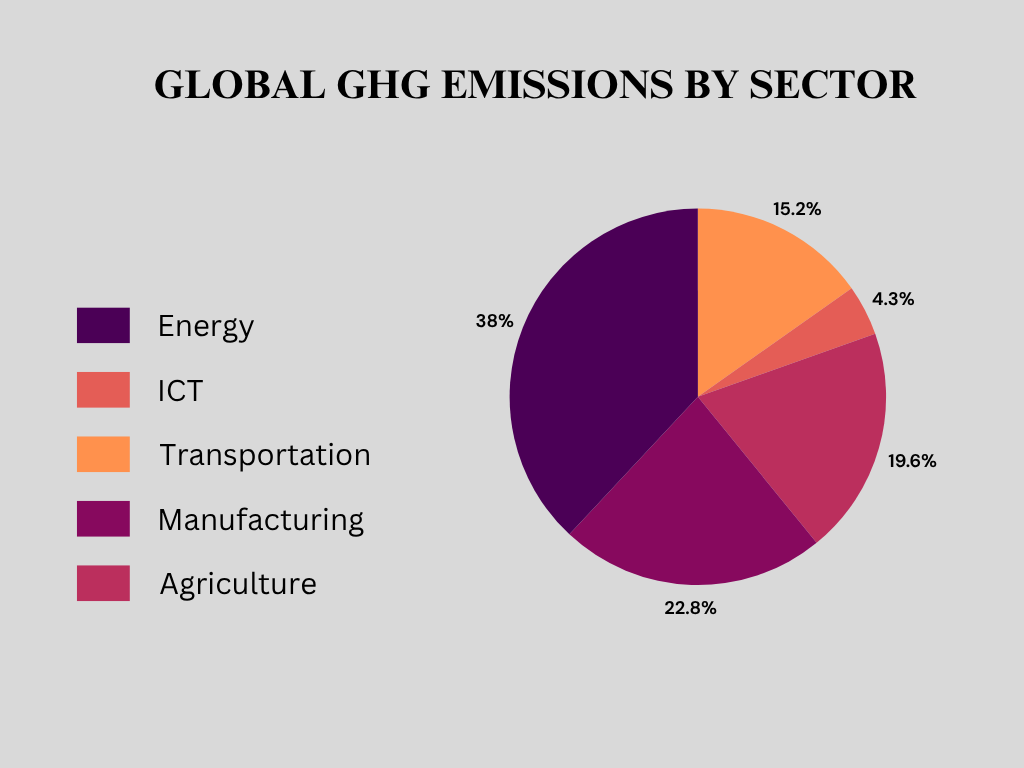Sustainable Web Design: 8 Tips to Build Eco-Friendly Websites
Global climate change and carbon emissions have been the subject of intense debate internationally. In recent decades, their impact on humanity has surpassed even concerns like overpopulation and food security. The truth is, the best way to tackle these growing challenges is for everyone to play their part; no matter what they do for a living.
In the Information and Communication Technology (ICT) sector, developers and engineers are responsible for around 1.5% to 4% of global greenhouse gas emissions. It might catch you off guard, but that's how it stands. Every time a developer creates a new page on a website or uploads a blog post, it has an environmental impact. So, what can be done about it? Website developers can reduce this damage by adopting sustainable web design practices.

In this blog post, we’ll share the top eight tips on how to create eco-friendly websites. By applying these tips in your daily web development projects, you can contribute to a healthier environment without sacrificing performance or the quality of your work.
3 Ways Websites Contribute To Climate Change
Websites that are built without considering sustainability and eco-friendliness can harm the environment in multiple ways.
1. High Carbon Emissions
Nothing can be more devastating for the climate than carbon emissions. Believe it or not, every website, whether it’s a simple service site or a high-end eCommerce store produces more carbon than you might think. Every new web page you create adds to your digital carbon footprint, which can ultimately be harmful to the environment.
When a visitor loads a new webpage, it generates about 0.8 grams of CO₂. In the US, the average person visits around 130 webpages each day. That means, on average, a single person is responsible for producing about 104 grams of carbon daily.
2. High Energy Use From Data Centers
Websites are intangible digital products, but that doesn’t mean they’re impact-free. Behind every click, or page load, there’s a physical process happening. All that website data lives in massive data centers, which store and serve up information every time someone visits your site. So, when a user clicks on a link or moves to a new page, a request is sent to a data center, and the center sends the right info back.
Powering these constant exchanges takes a huge amount of electricity. Most of which still comes from fossil fuels. Since data centers operate around the clock, the energy demand never really stops.
3. High Water Usage In Data Centers
Apart from carbon emissions, websites affect the climate in many different ways. Water which might seem unrelated to websites and databases is actually connected more than you might imagine. Water is used not only to cool down data centers but also to produce the electricity needed to power them. Water, a vital element for human existence, is often exploited for such ends without any checks in place.
8 Powerful Ways To Make Eco-Friendly Websites For Clients

1. Compress Image Size
Using images and high-end animations can make your web pages visually appealing and engaging. Website owners who invest in creating stunning, interactive experiences often see increased user time and higher conversion rates. However, images also contribute to a larger page size.
The more images you use, especially if they are not compressed, the heavier the page becomes. This results in higher energy consumption during loading, which ultimately leads to increased carbon emissions that are harmful to the environment.
Here’s what you can do.
Use online image compression tools such as Online Image Compressor, TinyPNG, and imageresizer to cut down the image size before uploading.
Change the image format from PNG and JPEG to Webp before uploading on the website. For this purpose, you can utilize tools such as CloudConvert and FreeConvert.
If you're using images solely to make a website look overly flashy without adding real value, it's better to avoid them whenever possible.
2. Delete Images From Media Library
Even if you're not tech-savvy or directly involved in web design and development, you've probably heard of WordPress. It's the most widely used content management system (CMS) in the world. According to research, around 529 million websites are built on WordPress. Many website owners and developers choose it for its user-friendly interface.
When you upload an image in WordPress, you use a feature called the “Media Library,” which handles all image-related functions. However, storing these images consumes energy. To reduce your website’s data usage and environmental impact, it's a good idea to regularly delete outdated or unused images from the Media Library.
3. Reduce Custom Fonts
Many things designers do might seem minor or have little impact on a website’s aesthetics, but they can actually cause significant harm to the environment. Typography is often a web designer’s first love, but it can be surprisingly harmful to the ecosystem. As a web design company, we’re not against using typography creatively. However, if it doesn’t enhance user engagement or improve the site's appearance, it’s best to avoid overuse.
Using two to three font styles is more than sufficient. Custom typography, especially those that require downloading, consumes extra data and increases a website’s carbon footprint. It can also make the site look overly stylized, potentially harming the user experienceveruse.
4. Use videos only when absolutely needed
What’s worse than overloading your website with unnecessary images? You guessed it: VIDEOS.
Videos are essentially thousands of images played in rapid sequence. So, when you add a video to your webpage, you're actually adding a huge load of visual data. Not only does this slow down your site’s loading speed, but it also increases energy consumption from data centers which takes a toll on our environment.
If you’re aiming to create an eco-friendly website, the best choice is to avoid videos altogether. But, sometimes videos are essential. In that case, here’s what you can do to reduce their environmental impact:
Reduce the video size by using free online video compression tools such as freeconvert.com and veed.io.
Trim the video to highlight only the key content. This way the video has a higher watch time.
Adjust the video size to ensure it doesn't obstruct any website content.
Always use a third-party video host (such as YouTube or Vimeo).
If you can, it's better to use an image instead of a video.
5. Build SEO-friendly Website
You may not realize it yet, but SEO can actually help with environmentally friendly websites. SEO is all about helping the right people, those genuinely interested in your product or service find your website by improving its ranking on search engines.
But here’s the eco-twist: when your site ranks well and shows up for the right audience, you reduce unnecessary traffic from people who bounce right off. That means fewer server requests, less energy use, and a smaller carbon footprint.
>Every time someone clicks on your website from the search results (SERP), energy is used to load the data that page contains. Now, whether that person is genuinely interested or just browsing, the same amount of energy is consumed. That’s why it's so important to attract the right people who are more likely to engage with your content or become customers.
6. Focus On Concise, High-Value Content
Every piece of content you add to your website increases the weight of the page. Heavier pages require more data to load from data centers which means more energy consumption. So if you think cramming your web pages with endless content will help boost your rankings, think again, that’s an outdated strategy. In fact, today’s best practice is all about keeping your content clear, concise, and purposeful.
Google now prioritizes websites that offer high-quality, user-focused content not 10,000-word pages filled with fluff. Your visitors don’t have time to read walls of text. Most people just skim for what they need. That’s why it’s essential to create value-driven content that gets straight to the point and answers your visitors' questions quickly.
7. Choosing A Green Web Host
If you ask us for one super simple tip to make any website more sustainable, it’s this: choose a green hosting provider. Seriously, that one decision can make a huge difference. This one tip takes almost no effort. A quick Google search or a quick chat with your current hosting provider’s customer support is all it takes. Just ask if they offer green web hosting. If they do, great! If not, no worries, you can always switch to one that doeseful.
Top 5 Green Web Hosting Providers.
Greengeeks LLC.io
DreamHost
Hosting.com
InMotion
SiteGround
8. Avoid Using No-Code Website Builders
No-code website builders have completely changed the game. Now, anyone can create a stunning, professional-looking website without writing a single line of code. We get it: not every business owner has the budget or time to build a fully custom site from scratch. That’s exactly why no-code tools have become so popular. In fact, over 70% of websites today are built using website builders, including no-code platforms.
But with all the great things no-code builders bring to the table, there’s one big drawback: they can be surprisingly harmful to the environment. These tools make it super easy to create countless pages in seconds, often bloated with unnecessary code that increases carbon emissions. There’s no doubt no-code platforms will keep growing in popularity, but that doesn't mean we can ignore the impact.
Experienced web development companies like Webnflix specialize in building eco-friendly websites even with no-code tools by optimizing for speed, performance, and sustainability.
Wrapping Up
Sustainable web development isn’t some far-off idea for the future. It’s something we need to care about right now. As technology and digital platforms grow, so does their impact on the environment, and that’s a problem we can’t afford to ignore any longer.
The sooner web developers start embracing eco-friendly websites and guiding their clients in that direction the better, it will get for the planet, and their careers too. Because, sustainable websites are quickly becoming the next big thing in web development. Those who get on board early lead the charge into a smarter, more sustainable digital future.
WEBNFLIX Wishes You Well For Your Next Design!




